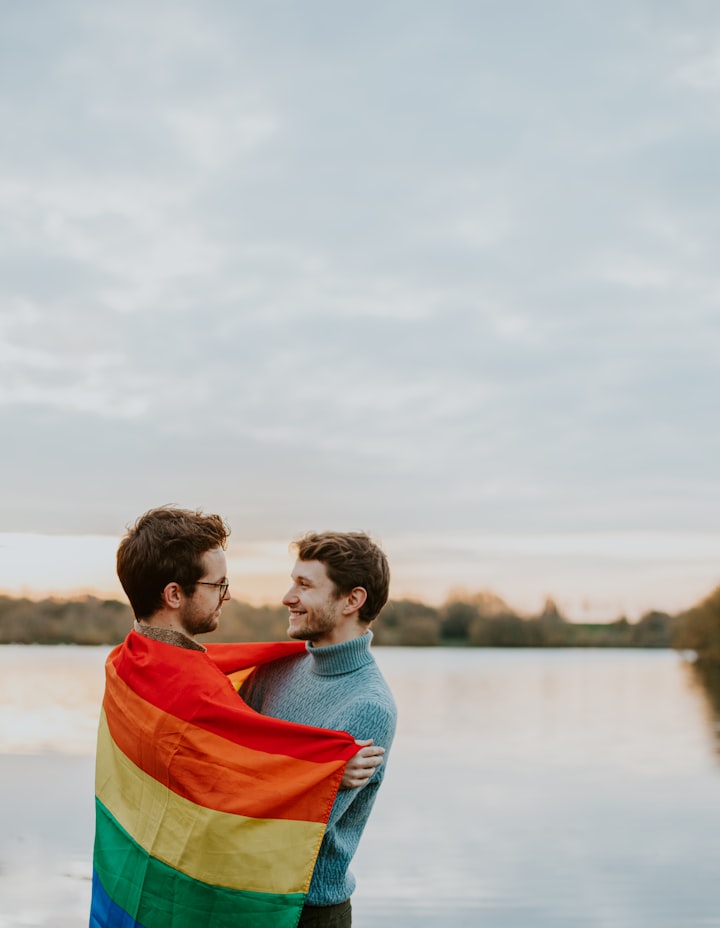LGBTQ+ characters on our screens changed my life!
Why it’s important to see LGBTQ+ characters on our screens, and why this is just the first step at representing the LGBTQ+ stories.

Representation of the LGBTQ+ community, not only on our screens but also in music, in theatre, in literature, in the media, feels more present than ever before. But it’s still not enough. ‘Netflix is going through a gay phase,’ is a comment I heard recently. As though it's something temporary and will pass. Here is why we are only just scratching the surface on LGBTQ+ representation.
Think back to the ’90s. Ellen comes out as gay in widespread, front page, world news. A figure that audiences have welcomed into their homes every week is gay. A scandal. It took many years for Ellen to become more than her sexual orientation. Gay, lesbian, bisexual, trans, asexual, queer, pansexual, all members of the community, had few (if any) examples on-screen to connect with. And let’s be honest here, still do.

I was trying to picture myself explaining my sexuality (something that is problematic as it is, we should strive to end anyone having to announce anything about their sexuality) to my parents say thirty, twenty, even ten years ago. Without using examples from TV shows that we watch together, and without being able to expose them to queer figures in the media, I don’t know how I would have been able to do it.
There weren't many role models that I could relate to on-screen growing up. And that was a lonely feeling. It’s only now that I can recognise the effect that had on my mental health as a child. Hiding this secret, this abnormality, whilst still figuring out where I land on the sexuality scale myself. I can still recall that overwhelming feeling that I didn’t belong, amongst all the other teenage drama, and let us not forget puberty! That was a lot on a twelve, thirteen-year-olds shoulders.
I grew up in the noughties. Any form of representation was still a big deal. Therefore, reinforcing on anyone growing up in the community that if you are anything other than straight, it’s going to be a big, huge life-changing deal. You are expected to be straight unless announced otherwise. I remember when I was younger hearing a family member talk about a famous gay musician, and there was a newspaper article about him going into backstreet toilets to have sex with men. Again, a scandal. The family member talked about it like something to be ashamed of. That all gay men were horny perverts dogging in alleyways. At the time I was starting to think of this guy friend I had in a romantic way. I pictured everyone thinking of me as this dark, scary creep only able to show affection in the shadows. I didn’t let myself think of him anymore. I repressed it.
The first time I remember seeing gay, lesbian, and bisexual characters was on an incredibly campy yet iconic show called Footballers Wives. I can still remember a line today from the football stud protagonist Conrad Gates, ‘I like sex! Man ... woman ... banana.’ I re-winded the quote over and over again on my DVD boxset. It was beyond my mind. Such confidence. He knew exactly who he was, and was completely unapologetic for it. I’d been to the cinema hundreds of times, I’d watched hundreds of TV series, but I’d never heard anything like it. Maybe it’s ok to have the thoughts I’ve been feeling? If Conrad can be free to love who he wants with such ease, then maybe I can too. Maybe I’m not alone.

Now let’s talk for a second about the portrayal of bisexual storylines. Firstly, I can count on one hand the amount of leading bisexual characters I’ve seen on TV or in film (and I've seen a lot of TV and film. Secondly, I can’t recall a single bisexual character (or any character showing some form of fluidity on the sexuality scale) that isn’t represented as either sleazy, or non-monogamous, or in some way unfaithful. Bisexual people don’t seem to get or deserve a happily ever after on screen – if you know one please send it to me. I would argue that this is why people who are attracted, somewhere on the scale, to both genders are some of the most unrepresented in the community. We can change that.
Let’s make something clear here. LGBTQ+ is not anything new, there have always been LGBTQ+ people. Exposing audiences to gay history, and queer culture isn’t some new fad. Seeing a gay character in a film doesn’t miraculously make someone gay. But just maybe representing more than the standard set of straight expectations, is giving people permission to feel accepted and to truly be themselves.

I am tired of having a queer story as an event, a big deal. If we see a character that is anything other than a straight, it’s a storyline, it’s everything that character is. It defines them. The character isn’t allowed to form anything more than their sexuality. Quite frankly, I’m bored of it.
I recently watched the incredible It’s a Sin. It highlighted to me that I am embarrassed how little I know about gay history. But where would I have learned about the AIDS crisis? Where would I have been informed about gay sex? We don’t get taught anything in schools. We don’t want to somehow infect pupils with gayness. Instead, we want the community to feel like they should have the hide who they are, live in fear, and alienate themselves in fear of being caught out as though anything queer is something criminal. That’s much better, right?

Modern Family is a landmark show for representing a gay couple adopting a baby. I honestly believe that Mitch and Cam have invited conversations to our household that never would have happened without Modern Family. The show touches on many issues through its run in a heart-warming comical way. It was ground-breaking ten years ago. I recently watched the series back, and as much as I enjoy the series, I was bugged by the earlier seasons focusing so much on them being a 'gay couple' rather than a 'couple'. I marked down that in almost every single episode there is a reference to them being gay, yet I don’t think there is a single mention that Phil and Claire are a 'heterosexual' married couple. In the latter seasons, this begins to change, and we start to see more fully rounded characters. But the show can’t quite resist reminding us again and again that they are different. They aren't normal (whatever that means.)

Finding anything LGBTQ+ was something that I had to seek out, a needle in a haystack. And what did that say to the thirteen-year-old me? It said the world is the haystack, and I was the needle. As an artist myself. I want to create stories, work, characters that represent all those thirteen-year-olds that for whatever reason beyond their control, feel like a needle. And all the makers out there, you are so important. I urge you to ask yourself with whatever art you are creating, whatever story you are telling, to ask yourself… Have we told this story before?... Have we seen this character a million times?... And how can I be more inclusive to include those who so often don't get to see themselves reflected on screen?
We all deserve that magic moment, don't we? Sitting in a movie theatre and you are watching a movie that connects with you so deeply that you suddenly feel seen. That's the magic of cinema. I truly believe what we see on our screens can change the world.
There’s a difference between tolerance and acceptance. Previous generations were taught tolerance. Tolerating anyone different. Yet we’re starting to no longer just tolerate, but accept. Accepting someone fully and truthfully, and seeing people for all their wonderful uniqueness, not their born statistics. A big part of this change stems from our screens. A change that has only just started in the last few years.
I’m so incredibly excited about the content we are creating. There’s a presence starting like never before for LGBTQ+ characters and stories. TV is moving faster than film it seems. If there’s a film about a gay character, usually it’s an independent coming out film. We are still seeing firsts all the time. The first mainstream film with a gay protagonist was only in 2018, the first gay superhero is in the works, the first gay character in a Pixar film was announced last year. Onward featured a passing comment of a female police officer mentioning her girlfriend. This caused outrage. Widespread news. Boycotts. The moment lasted less than ten seconds and having a minor character with such a fleeting comment was almost just as offensive as having not having it at all.
We’ve told the coming out story before, an important story to tell, but that’s been told. Now let’s explore all the possibilities to normalise LGBTQ+ on our screens.
About the Creator
John Thacker
Hello...
I am a writer, actor, and singer/songwriter from Manchester, UK.
Catch up with me on the socials...
instagram.com/johnjjst
twitter.com/johnjjst






Comments
There are no comments for this story
Be the first to respond and start the conversation.